破茧 JDBC:MyBatis 在 Spring Boot 中的轻量实践录
一、什么是 MyBatis
通过 MyBatis中文网站 我们了解到 “MyBatis 是一款优秀的持久层框架 ” ,用于简化JDBC的开发,而此处 “ 持久层 ” :指的是持久化操作的层,通常指数据访问层(Dao),用来操作数据库
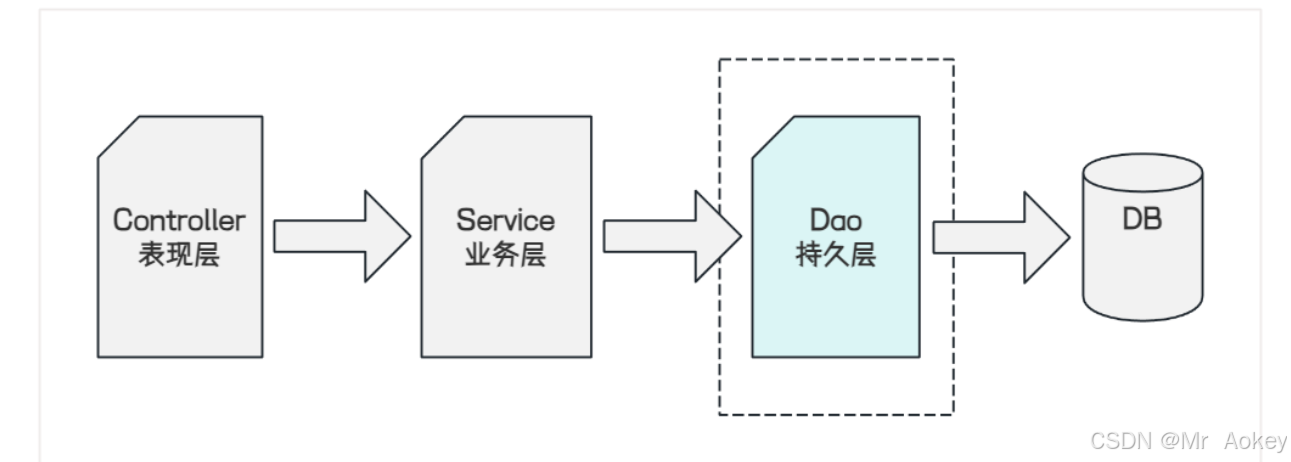
换句话说,MyBatis 是更简单的完成程序与数据库交互的框架,即更简单方便地操作和读取数据库工具
二、 MyBatis 入门
2.1、创建项目
创建 Spring Boot 项目,并导入 MyBatis 启动依赖和 MySQL 驱动包
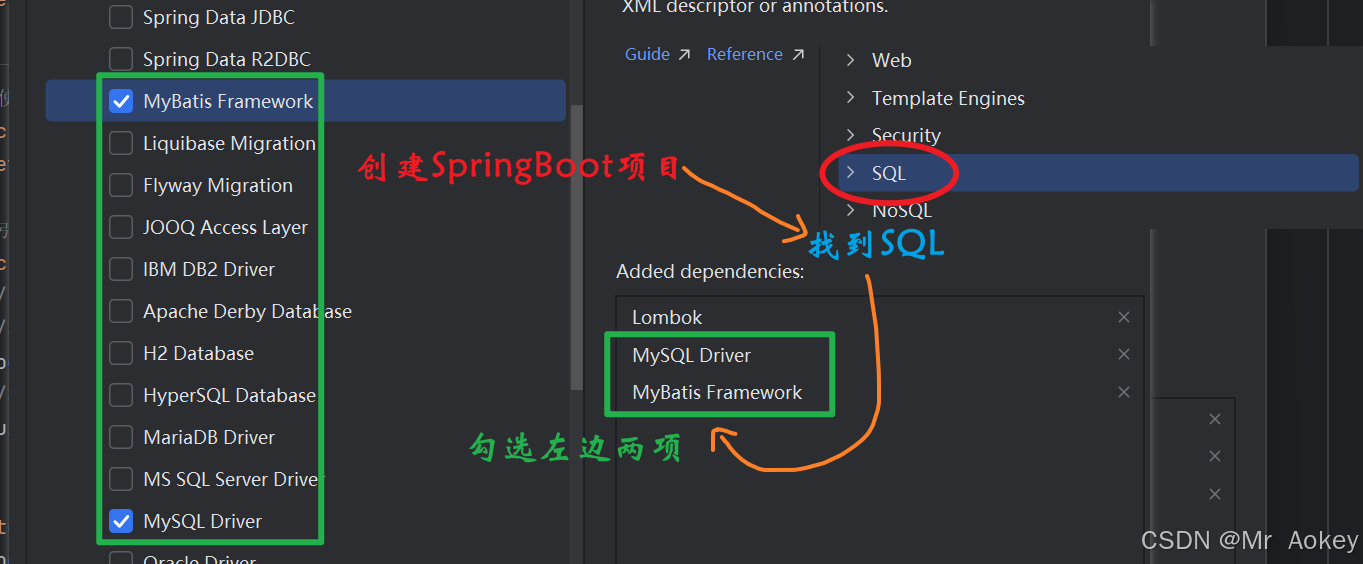
创建用户表,并创建对对应的实体类 UserInfo

@Data
public class UserInfo {private Integer id;private String username;private String password;private Integer age;private Integer gender;private String phone;private Integer deleteFlag;private Date createTime;private Date updateTime;
}
数据库规范:全部小写,单词之间用下划线分割( _ )
Java规范: 属性使用小驼峰来表示
注意:我们创建表和实体类中,要把数据库字段和Java属性一一对应起来
2.2、配置数据库连接字符串
在 application.yml 配置文件中配置如下:

2.3、入门操作
MyBatis 采用 “ 接口+XML/注解 ” 的方式实现数据访问层,实现了接口与实现的分离,其核心机制为:在运行时为接口生成动态代理对象,即自动创建它的实现类,能够轻松创建mock实现进行单元测试
MyBatis 在运行时通过 动态代理(Dynamic Proxy) 机制自动生成了接口的实现类
我们接下来查询所有用户
@Mapper
public interface UserInfoMapper {@Select("SELECT * from user_info")List<UserInfo> selectAll();
}@Mapper注解:标识该接口为 MyBatis 的 Mapper 接口
• 运行时框架会自动生成接口代理对象,并交由 Spring IOC 容器管理
• @Select 注解:用于标记查询方法,定义对应 SQL 查询语句
2.4、单元测试
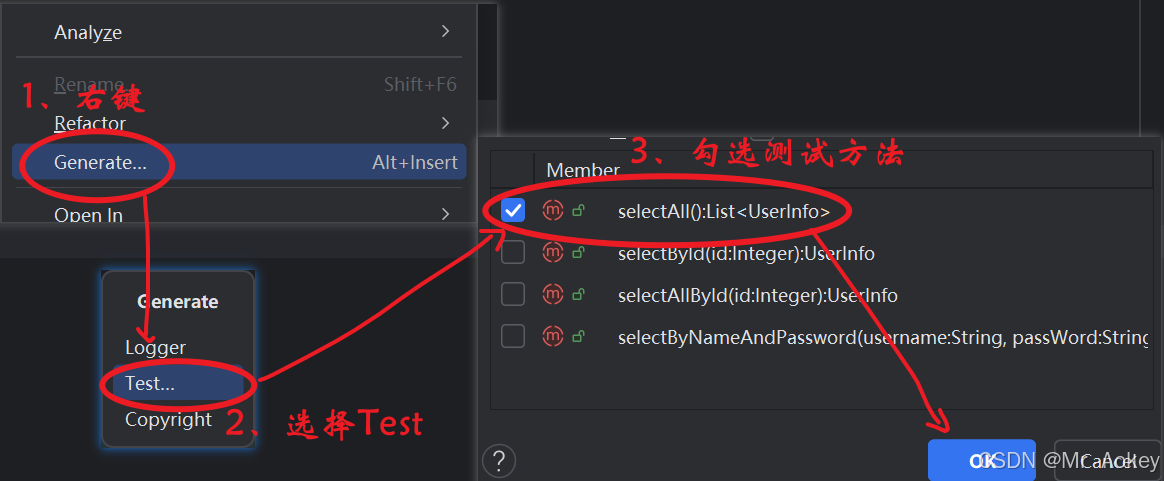
测试类已在 src/test 目录下自动生成,可直接用于测试
@SpringBootTest
class UserInfoMapperTest {@Autowiredprivate UserInfoMapper userInfoMapper;@Testvoid selectAll() {List<UserInfo> userInfos = userInfoMapper.selectAll();System.out.println(userInfos);}
}在该测试类上添加了 @SpringBootTest 注解后,运行时将自动加载 Spring 运行环境;方法加上@Test 注解后,该方法即可单独运行;通过@Autowired 注解注入待测试的类后,即可开始进行测试
运行结果:成功查询了所有用户的信息

三、MyBatis基础操作(增删改查)
3.1、配置日志
在MyBatis中我们可以借助日志,查看SQL语句的执行,传递的参数以及执行的结果,在application.yml 配置文件中配置(properties文件配置查阅前篇)
mybatis:configuration: # 配置打印 MyBatis⽇志log-impl: org.apache.ibatis.logging.stdout.StdOutImpl配置后可以看到

3.2、参数传递
查询 ID 为 3 的用户
@Mapper
public interface UserInfoMapper {@Select("select username,password,age,gender,phone from user_info where id = #{id}")UserInfo selectById(Integer id);
}当 Mapper 接口方法的形参仅有一个普通类型参数时,# {...} 中的属性名称可以任意指定,但是如果形参有多个普通类型的参数时,属性名称必须对应(见3.3例中代码)
生成测试用例:#{id}
@Testvoid selectById() {UserInfo userInfo = userInfoMapper.selectById(3);System.out.println(userInfo);}查询结果:

可通过@Param 注解设置参数别名。若使用 @Param 设置别名,#{...} 中的属性名必须与 @Param 指定的别名保持一致
@Select("select username,password,age,gender,phone from user_info where id = #{userID}")UserInfo selectById(@Param("userID") Integer id);
⚠️注意:
@Select("SELECT * from user_info")List<UserInfo> selectAll();@Select("select username,password,age,gender,phone from user_info where id = #{userID}")UserInfo selectById(@Param("userID") Integer id);@Select("select username,password,age,gender,phone from user_info where age = #{age}")List<UserInfo> selectAllByAge(Integer age);
3.3、增(Insert)
目标SQL语句:

插入另一条数据,并将SQL中的常量替换成动态的参数:
@Insert("insert into user_info (username, password, age, gender, phone) values (#{username}, #{password}, #{age}, #{gender}, #{phone})")Integer insert(UserInfo userInfo); @Testvoid insert() {UserInfo userInfo = new UserInfo();userInfo.setUsername("楚子航");userInfo.setPassword("123456");userInfo.setGender(1);userInfo.setAge(19);userInfo.setPhone("122222222222");int result=userInfoMapper.insert(userInfo);System.out.println("影响的行数"+result);}在 MyBatis 中,insert() 方法返回的结果和在MySQL中返回的结果是一样的,都是返回影响的行数,观察测试结果:

返回主键
我们想在插入之后,拿到刚刚插入的数据ID
@Options(useGeneratedKeys = true,keyProperty = "id")@Insert("insert into user_info (username, password, age, gender, phone) values (#{username}, #{password}, #{age}, #{gender}, #{phone})")Integer insert(UserInfo userInfo);@Testvoid insert() {UserInfo userInfo = new UserInfo();userInfo.setUsername("路鸣泽");userInfo.setPassword("123456");userInfo.setGender(1);userInfo.setAge(16);userInfo.setPhone("11111111111");int result=userInfoMapper.insert(userInfo);System.out.println("影响的行数"+result+" id:"+userInfo.getId());}• useGeneratedKeys:启用后,MyBatis 将调用 JDBC 的 getGeneratedKeys 方法来获取数据库自动生成的主键(如 MySQL 和 SQL Server 中的自增字段),默认值为 false
• keyProperty:指定用于标识对象的唯一属性,MyBatis 会通过 getGeneratedKeys 的返回值或 insert 语句的 selectKey 子元素为其赋值
注意:
设置 useGeneratedKeys=true 后,方法返回值仍是受影响的行数,自增 ID 会被自动赋给 keyProperty 指定的属性
3.4、删(delete)
 将上述SQL中的常量替换为动态参数
将上述SQL中的常量替换为动态参数
@Delete("delete from user_info where id = #{id}")void deleteById(Integer id); @Testvoid deleteById() {userInfoMapper.deleteById(9);}观察运行结果发现Id为 9 的数据已被删除

 3.5、改(update)
3.5、改(update)

将上述SQL中的常量替换为动态参数
@Update("update user_info set username = #{username} where id = #{id}")void updateById(UserInfo userInfo); @Testvoid updateById() {UserInfo userInfo = new UserInfo();userInfo.setId(5);userInfo.setUsername("喜羊羊");userInfoMapper.updateById(userInfo);}观察运行结果发现Id为 5 的数据名称已经更改为喜羊羊了

3.6、查(select)
我们再次查询所有信息
@Select("select id,username,password,age,gender,phone,delete_flag,create_time,update_time from user_info")List<UserInfo> selectById(); @Testvoid selectById() {List<UserInfo> userInfoList = userInfoMapper.selectById();System.out.println(userInfoList);}从运行结果可以看出,SQL语句中查询了 delete_flag、create_time 和 update_time 字段,但这些字段并未被赋值
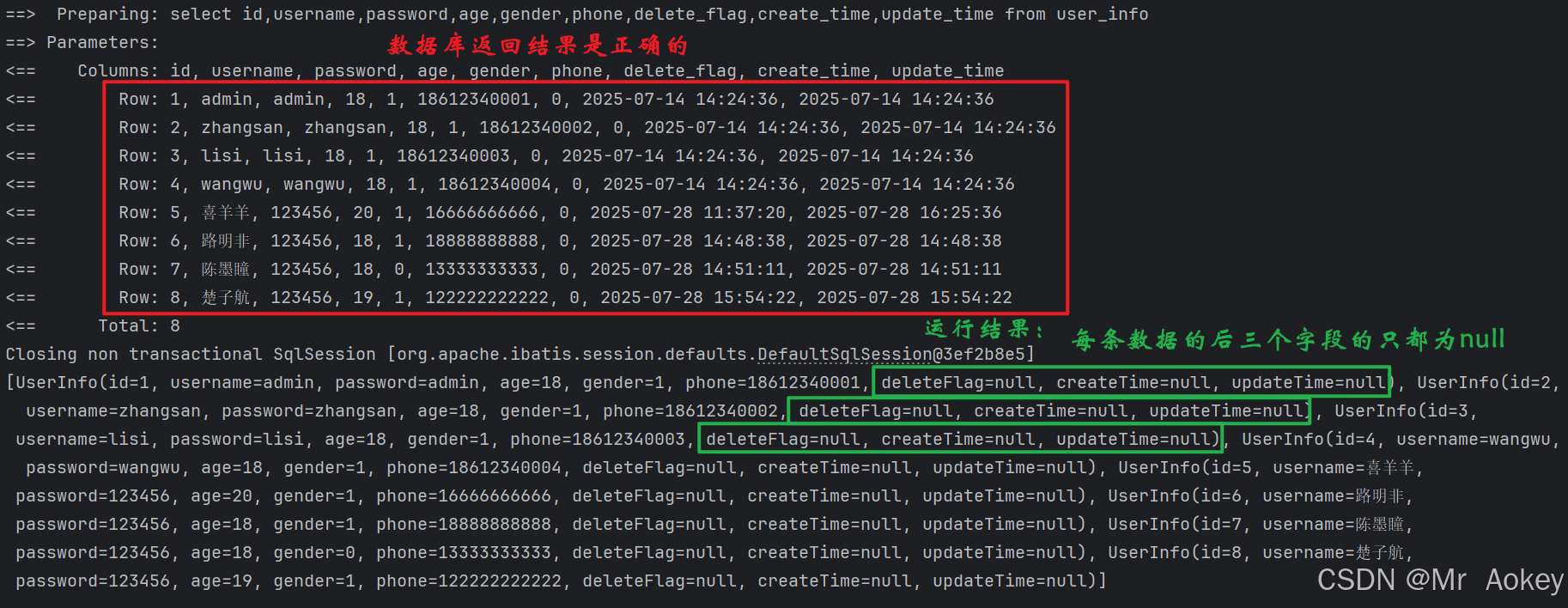
为什么呢? 这时我们会想到是不是 Java 属性和数据库字段对应的名称不一致造成的原因呢?
@Select("select id,username,password,age,gender,phone," +"delete_flag as deleteflag,create_time as createtime,update_time as updatetime " +"from user_info")List<UserInfo> selectById();
运行结果:

MyBatis在自动映射查询结果时,会按以下步骤处理:
- 获取查询结果返回的列名
- 在目标Java类中查找名称匹配的属性(不区分大小写)
- 当列名与属性名匹配时(例如数据库列"ID"对应Java属性"id"),自动将列值映射到对应属性
解决方法
3.6.1、起别名
如上猜测,将数据库字段名称通过起别名的方法与Java属性名称保持一致,另外我们从下方代码可见SQL语句可以用 + 连接
@Select("select id,username,password,age,gender,phone," +"delete_flag as deleteflag,create_time as createtime,update_time as updatetime " +"from user_info")List<UserInfo> selectById();3.6.2、结果映射
@Results 注解用于建立数据库字段与 Java 对象属性之间的映射关系,它包含一个由 @Result 元素组成的数组,其中每个元素通过 column 指定数据库列名,property 指定对应的 Java 属性名,从而实现二者之间的映射关联
@Results({@Result(column = "delete_flag",property = "deleteFlag"),@Result(column = "create_time",property = "createTime"),@Result(column = "update_time",property = "updateTime")})@Select("select id,username,password,age,gender,phone,delete_flag,create_time,update_time from user_info")List<UserInfo> selectResult();现在的问题是:我们上述代码实现了众多增删改查方法,每个方法进行结果映射都需要字段复制操作,如果其他方法涉及不同的数据库字段,来回修改会非常不便。在Aokey看来,这并不比使用别名便利
针对这种情况,我们可以通过 Id 属性为 Results 定义别名,然后使用 @ResultMap 注解来复用其他已经定义的 ResultMap 配置
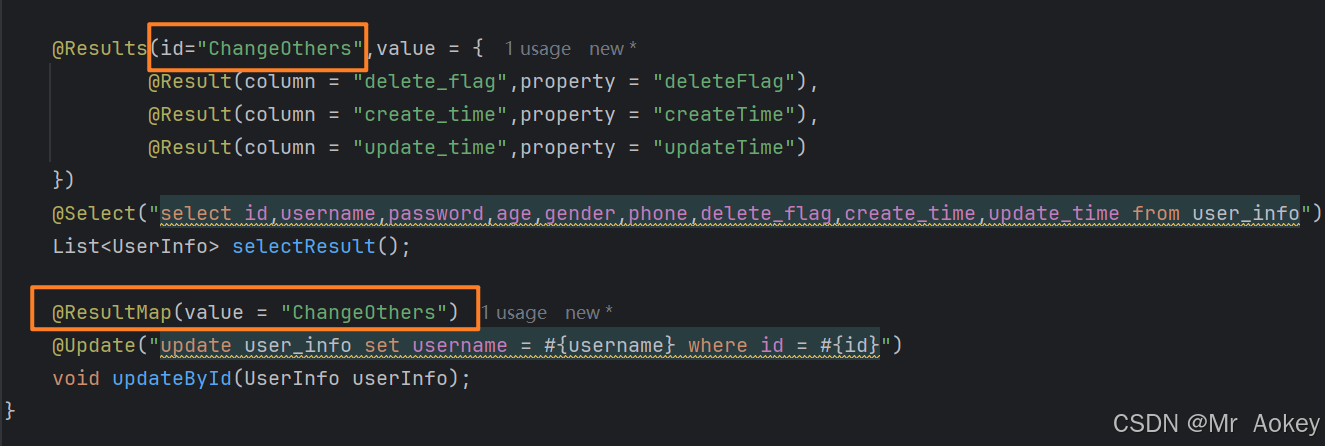
3.6.3、 配置驼峰自动转换
在 application.yml 配置文件中配置如下:
mybatis:configuration: map-underscore-to-camel-case: true #配置驼峰⾃动转换 @Select("select id,username,password,age,gender,phone,delete_flag,create_time,update_time from user_info where age = #{age}")List<UserInfo> selectAllByAge(Integer age);查询结果:



